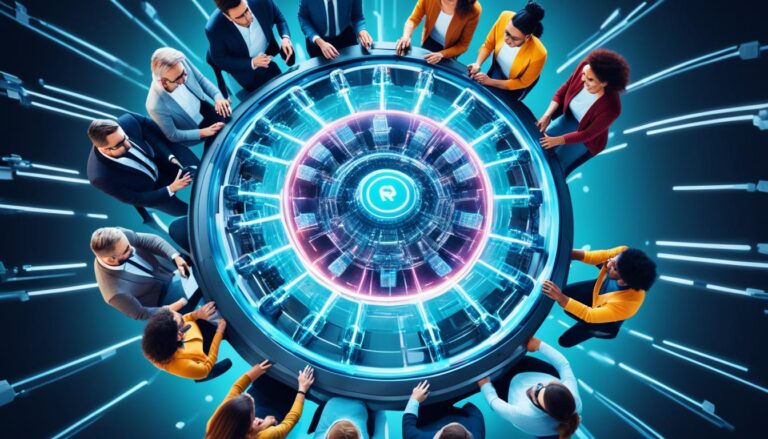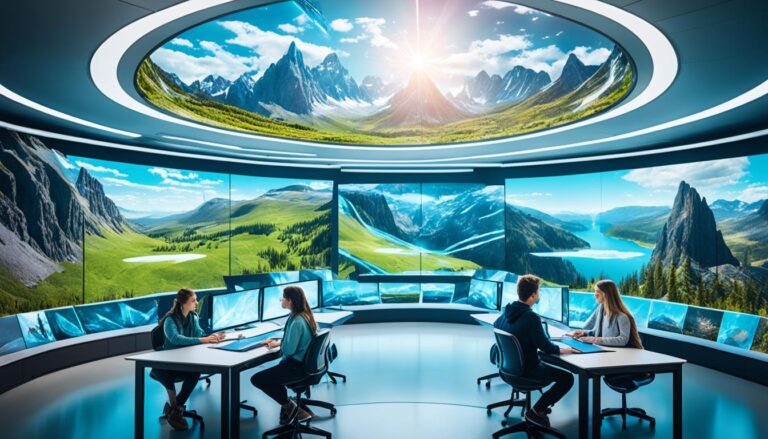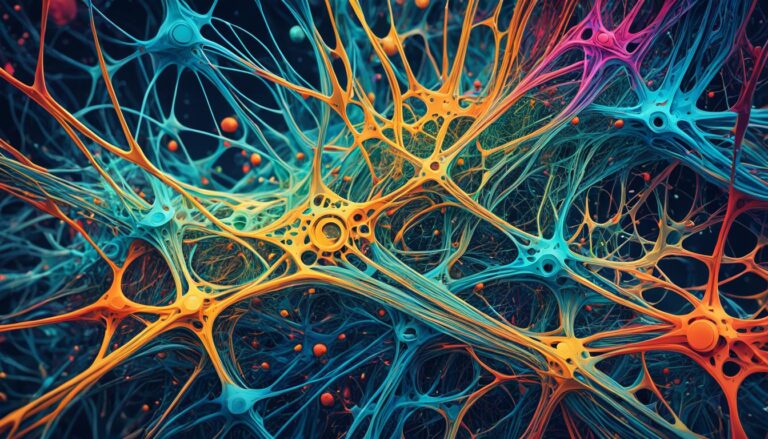Kai is an artificial intelligence robot changing how we interact with AI. It combines humanoid robotics and generative AI. This lets Kai greet people warmly, use real-like gestures, and talk smartly.
Thanks to high-tech sensors, actuators, computing, and machine learning, Kai is very lifelike. This tech allows for more real and interactive AI robot experiences. Kai is making big changes in the world of AI.
The Evolution of Humanoid Robotics
Humanoid robotics has seen huge steps forward. They aim to copy human anatomy and actions closely. With their two-legged design, these robots show great skill in doing tasks and moving in places made for humans. They aim to use tools meant for human hands, move in human spaces, and copy our actions accurately.
Recent steps forward in sensors and actuators have made humanoid robots seem more life-like. These improvements help robots move and express themselves better. This makes interacting with them feel more real and enjoyable.
As a visual representation of this evolution, consider the following table, showcasing notable advancements in humanoid robotics:
| Year | Advancement | Impact |
|---|---|---|
| 2000 | ASIMO by Honda | Significant progress in bipedal locomotion |
| 2010 | Atlas by Boston Dynamics | Enhanced agility and balance |
| 2016 | Sophia by Hanson Robotics | Human-like facial expressions and social interaction |
As humanoid robots get better, the difference between their skills and human ability gets smaller. These improvements bring us closer to a time when robots will work well with us. They will add to our skills and change many industries.
To illustrate the humanoid robotics, functionality, and mimicry of human anatomy, refer to the image below:
The progress in humanoid robotics is a big step towards combining machine and biological features. By imitating human actions and behavior, these robots are becoming better suited for human environments. This opens up exciting opportunities in many areas.
The Power of Generative AI
Generative AI is a fascinating part of artificial intelligence that creates content. It uses deep learning models to make new text, images, audio, and code. This tech is changing industries and expanding what AI can do.
Deep learning models like GANs and VAEs are central to generative AI. Trained on huge datasets, these models can make new content. It’s like what humans might produce.
Consider OpenAI’s GPT-3. This model writes coherent text that looks like a human wrote it. It can create stories, poems, and accurately answer complex questions.
DeepMind’s AlphaFold is another great example. It has greatly improved protein folding research. This model accurately predicts protein structures. This could lead to new drugs and a better understanding of biological processes.
Capturing human creativity, generative AI is innovating and changing industries worldwide.
Beyond text and protein folding, generative AI boosts creativity in many areas. It makes realistic images, composes music, and aids in design tasks. In virtual reality and gaming, it creates immersive worlds and characters.
Examples of Generative AI in Action
Here are some ways generative AI is used:
- It can write blog posts, news articles, or product descriptions on its own.
- For art and design, generative AI makes unique patterns and helps artists.
- In video editing, it automates scene detection and creates deepfake effects.
- The music industry uses it to compose scores and create songs for specific moods.
Generative AI’s future looks bright, with endless possibilities. It’s helping with scientific research and improving our daily lives. This amazing technology is set to change our future.
Realism and Responsiveness in Modern Humanoid Robots
Robots like Boston Dynamics’ Atlas and Hanson Robotics’ Sophia lead in tech, breaking new ground. They merge generative AI into their makeup. This lets them sense, react, and solve problems uniquely.
These humanoid robots mimic human actions and expressions well. Thanks to advanced sensors and actuators, they move smoothly and life-like. This mimicry creates a bond, making interactions with them feel more natural.
“In the realm of robotics, we aim to create machines that can seamlessly blend into human-centric environments, responding to stimuli in ways that are both natural and authentic.”
These robots also learn from their interactions and get better over time. Through ongoing feedback and learning, they adapt to change well. This makes them anticipate and meet human needs better, inviting more dynamic interactions.
Key Features of Realism and Responsiveness in Modern Humanoid Robots:
- Integration of generative AI for adaptive and creative problem-solving
- Sophisticated sensors and actuators for nuanced movements and expressions
- Learning from interactions to refine behaviour and adapt to unpredictable settings
Check the table below to see how Boston Dynamics’ Atlas and Hanson Robotics’ Sophia compare:
| Feature | Boston Dynamics’ Atlas | Hanson Robotics’ Sophia |
|---|---|---|
| Nuanced movements | ✔ | ✔ |
| Facial expressions | ✔ | ✔ |
| Learning capability | ✔ | ✔ |
| Adaptability | ✔ | ✔ |
Modern humanoid robots are transforming industries, such as healthcare, customer service, and entertainment. They close the gap between humans and machines. This leads to better productivity, efficiency, and personalised experiences.
The Synergy of Hardware and Software in Humanoid Robotics
The growth of humanoid robotics shows how hardware and software have advanced together. High-tech hardware and smart software have led to a new level of functionality. This makes humanoid robots more useful and capable than ever before.
For humanoid robots to work well, they need lots of computing power. This lets them handle complex tasks easily and accurately. With this power, robots can sense their surroundings, decide on actions, and carry them out precisely.
Better batteries and energy use have also helped. Now, humanoid robots can work longer without needing a recharge. This means they can be more useful in various tasks without stopping.
Machine learning is at the core of these advances. It lets humanoid robots learn from what they do and adjust to new things. This way, they get smarter over time. This reduces the need for people to always guide them, allowing them to do things on their own.
These robots can notice patterns, understand data, and make smart choices thanks to machine learning. They learn from lots of data. This helps them get a good understanding of their surroundings. Being able to learn and adapt is important for making robots versatile in different situations.
The Role of Software: Enabling Intelligent Autonomy
Software is key for making humanoid robots smart and independent. The software is built to use the robot’s hardware to the fullest. It helps with noticing things, making decisions, and then acting on them.
Perception software helps robots understand their environment. They use sensors like cameras and microphones to gather information. Then, they analyze this info to make smart choices.
Decision-making software processes what the robot senses. It helps the robot navigate and act on its own. This software is why robots can handle complex surroundings and interact with people.
Software for action execution translates decisions into actions. This controls the robot’s movements precisely. It’s why robots can move and perform tasks just like humans do.
The Importance of Hardware: Enabling Physical Interaction
Even though software is crucial, hardware matters just as much. Humanoid robots have sensors and parts that let them mimic human actions. This makes interactions with them feel more natural.
Advanced sensors allow robots to see their world in detail. They can recognize things, track movements, and understand expressions. This makes interactions with humans much more meaningful.
Actuators and motors give robots the ability to move and interact physically. They can gesture, move about, and handle objects in ways that seem very human.
The design of humanoid robots, like walking on two legs, is key. It lets them move in spaces made for humans, walk on rough surfaces, and stay balanced. This design is essential for many tasks.
The success of humanoid robots comes from combining great hardware with smart software. It’s this mix that lets them act and interact in ways that are very human-like. They can do tasks with care and work on their own because of this synergy.
Sensory Perception and Human-Like Interaction
Sensory perception is key to improving humanoid robots. It helps them interact with humans in a natural way. They use high-res cameras, tactile sensors, and advanced audio tech. This lets them make sense of their environment with great detail.
High-resolution cameras help these robots see clearly. They can identify objects and facial expressions. They can also understand body language. This boosts their ability to get and respond to human emotions.
“Tactile sensors let robots feel touch, pressure, and texture. This gives them a better grasp of the physical world,”
says Dr. Sarah Thompson, a top robotics researcher.
Robots can now understand speech thanks to advanced audio tech. They can tell voices apart, catch different tones, and recognize languages. They can have real conversations. They answer questions and even get the context. This creates a more engaging interaction.
These robots take in lots of sensory info. They then use AI to make sense of it all. This AI doesn’t just help with talking but also with moving. Robots can change what they do based on their surroundings.
“AI lets robots act in more human-like ways,”
explains Dr. James Anderson, an AI robotics expert.
“They can do things that fit the situation around them better.”
By combining sensory perception with AI, humanoid robots interact more smartly with humans. They understand and react to emotions. They join in on conversations. They adjust their moves for different scenarios. This all leads to a more lifelike experience.
Enhancing Human-Robot Interaction with Sensory Perception
Developments in sensory tech greatly impact human-robot interaction. Here’s how they make these interactions better:
- Improved Emotional Understanding: Robots can now read faces, gestures, and tones. This lets them better understand human emotions. It helps create deeper, more caring interactions.
- Enhanced Personalization: Robots can change how they act for each person. They do this by analyzing sensory cues. This makes interactions more personal.
- Real-time Adaptation: Robots can quickly change their behavior based on new feedback. This makes their actions more smooth and responsive.
- Efficient Collaboration: Better sensory perception means robots can work with humans more effectively. They understand complex orders and help with tasks.
- Improved Accessibility: These robots can help people with different needs. They do this by making sense of sensory information. This offers more support in many situations.
As robots get better at sensing, our interactions with AI become more natural and true-to-life. This opens up new chances in many fields and uses.
Impacts Across Industries
Humanoid robots and generative AI are changing many fields. These include healthcare, surgery, manufacturing, customer service, education, and entertainment. Let’s look at how these technologies are making a difference.
1. Healthcare
Humanoid robots are making healthcare safer. They disinfect rooms, deliver medicine, and keep patients company. These robots can move around hospitals on their own. This reduces infection risks and lets doctors focus on urgent care.
2. Surgery
In surgery, robots with generative AI are now essential. They help surgeons with amazing precision, making operations less invasive. These robots analyze data in real-time. They help make better decisions and work more efficiently in surgeries.
3. Manufacturing
Humanoid robots boost efficiency in manufacturing. They mimic human movements for complex tasks. This increases productivity and quality. By taking over repetitive tasks, they make workplaces safer and let humans focus on specialised work.
4. Customer Service
Customer service has been transformed by humanoid robots. They talk to customers and help solve their problems in real-time. Their ability to process natural language means they can understand and respond to inquiries. This improves customer service and satisfaction.
5. Education
In education, humanoid robots are proving to be useful. They offer customised and interactive learning. They can adjust to how each student learns, offering a new way to present lessons. This could change how classes operate and meet students’ needs.
6. Entertainment
Humanoid robots are also entering the entertainment world. They create unique content, improving theme parks and shows. These robots can engage with audiences in ways that captivate and entertain. They are creating new kinds of amusement experiences.
Humanoid robots and generative AI are setting new standards in various industries. They offer improved efficiency and services, bringing innovative solutions. As these technologies progress, they will keep changing our world in exciting ways.
Conclusion
The future of humanoid robotics and AI is filled with exciting opportunities and important concerns. These advances can change industries, improve work, spark innovation, and offer custom solutions. But, it’s vital to tackle ethical issues to use them responsibly and keep privacy safe.
As humanoid robotics and AI evolve, their impact on society needs careful handling. We have to find a good mix of human and AI abilities. This balance will help us get the most out of these technologies. At the same time, we’ll keep what makes us human.
Looking ahead, we must weigh both the good and bad sides of humanoid robotics and AI. By keeping ethics in mind and innovating responsibly, we can create a positive future. A future where technology helps us succeed and respects our human values and ethics.
FAQ
What is Kai?
Kai is an artificial intelligence robot. It changes how humans and AI talk by using real-looking robots and smart AI.
What are humanoid robots?
Humanoid robots look and act like humans. They often walk on two legs.
What is generative AI?
Generative AI is a type of AI. It creates new and believable content.
How realistic and responsive are modern humanoid robots?
Today’s humanoid robots, like Boston Dynamics’ Atlas and Hanson Robotics’ Sophia, seem very real and react well. They’re better due to new sensors and technology.
How does hardware and software contribute to humanoid robotics?
Powerful computers and learning algorithms help humanoid robots work smoothly.
How do humanoid robots interact with the world?
Humanoid robots use advanced sensors and smart AI. This lets them understand and interact in a human-like way.
What industries are benefiting from humanoid robots and generative AI?
Many areas like healthcare, making things, customer help, teaching, and fun are getting better with these new techs.
What are the future implications and considerations regarding humanoid robotics and AI?
We need to think about moral issues, effects on society, and new rules. This is key for using humanoid robots and AI right.


















